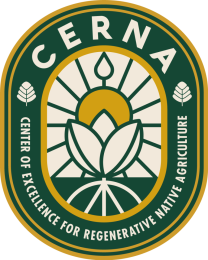Iowa Tribe of Kansas and Nebraska’s Center of Excellence For Regenerative Native Agriculture
Helping Farmers Transition to Regenerative Agriculture
The Center of Excellence for Regenerative Native Agriculture (CERNA) helps farmers and ranchers transition from conventional to regenerative agriculture. Through education, training, and technical assistance, we provide participants with the skills to apply regenerative practices, and access to new premium markets.
Complimentary benefits for participants include:
- Multi-day intensive course on regenerative agriculture techniques, soil health, ecology, and on-farm practice implementation for two cohorts per year.
- Incentives for implementing regenerative practices.
- Haney soil testing and other key soil health analytics.
- Assistance in reducing costly chemical inputs that improve the farm’s bottom line.
- Customized farm management plan.
- Peer-to-peer networking opportunities.
- Ongoing technical assistance.
- Premium markets and contracts for enrolled crop commodities (including corn, soybeans, sunflowers, wheat, barley, sorghum, oats, hemp, livestock, and more).
What is Regenerative Agriculture?
Regenerative agriculture is a mindset that builds a relationship with natural systems, imitating nature’s beauty, principles, patterns, and intelligent design. It facilitates the healing of human and biological communities and is increasingly sought after by consumers.
Regenerative agriculture looks like:
- Reduced/no-tillage: minimizing soil disturbance to preserve soil structure and organic matter.
- Cover cropping/intercropping: growing plants to cover the soil between cash crop seasons, preventing erosion and replenishing nutrients.
- Mulching: applying organic materials like compost or crop residues to the soil surface to retain moisture and suppress weeds.
- Water conservation: Enhanced soil aggregation allows for increased water cycling infiltration and greater water holding capacity, improving water efficiency in dryland and irrigated systems while improving drought resilience.
- Nutrient management: increasing soil health and function increases natural nutrient cycling, reduces the need for costly synthetic fertilizers.
- Livestock integration: grazing animals increase soil health and function by increasing nutrient cycling and providing weed control. Livestock integration also increases economic resilience and improves soil biology.
- Reduced synthetic inputs: minimizing the use of synthetic fertilizers, pesticides, and other chemicals.
- Biodiversity enhancement: increasing the variety of plant and animal species that support ecosystem functions. Increases honey production and improves beneficial insects that regulate pest populations.
- Prescribed burns: carefully controlled fires manage vegetation and improve soil health.

How is CERNA Funded?
CERNA is a program of the lowa Tribe of Kansas and Nebraska. CERNA was awarded a $5 million grant from the United States Department of Agriculture (USDA) over a five-year period to support this work. It has the potential to help farmers and ranchers reduce their environmental impact while also improving their bottom line.
Want to Apply or Learn More?
